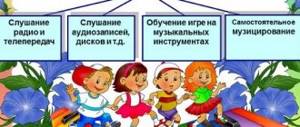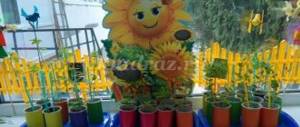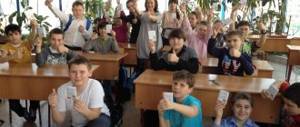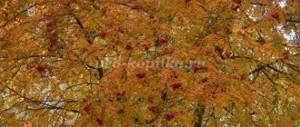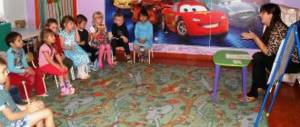Page 1 of 6
Working with parents on environmental education of preschool children is one of the components of the work of a preschool institution.
Only by relying on the family, only by joint efforts can we solve our main task - raising a person with a capital “H”, an environmentally literate person. Nowadays, the problems of environmental education have come to the fore, and more and more attention is being paid to them. Why did these problems become relevant? The reason is human activity in nature, which is often illiterate, incorrect from an environmental point of view, wasteful, leading to a disruption of the ecological balance.
Each of those who brought and are causing harm to nature was once a child. That is why the role of preschool institutions in the environmental education of children, starting from an early age, is so great. Our task is to show parents the need to instill an environmental culture in their children. What does the concept of “ecological culture” include? Ecological culture is knowledge, practical skills, aesthetic experiences - emotional attitude and practical actions and behavior of children (empathy, compassion, interest and desire to help nature, the ability to admire its beauty, etc.).
When working with parents on environmental education of children, it is necessary to use both traditional forms (parent meetings, consultations, conversations, conferences) and non-traditional ones (business games, pedagogical services bureau, direct telephone, round table, discussions). But all these forms must be based on a pedagogy of cooperation. Work should be carried out in two directions:
- teacher - parent;
- teacher - child - parent.
Before planning your work, you need to understand who you will be working with (the educational level of the parents, the psychological state of the family, its microclimate). This means that it is important to carry out work in a differentiated manner, uniting parents into subgroups.
The need for an individual approach is also determined by the following. Traditional forms of work, designed for a large number of people, do not always achieve the goals that we set for ourselves.
When choosing forms of communication with parents, we must remember: we should abandon edification, we must involve parents in solving important problems, finding common correct answers. For example, when organizing a parent meeting on the topic “Tasks of environmental education,” the educator can conduct a preliminary survey of parents to find out their understanding of the problems associated with environmental education (Appendix 1). The parent meeting can begin with KVN between a team of children and parents, then, after the children leave, analyze this event together with the parents and draw conclusions:
- the fundamentals of environmental education are aimed at developing a responsible attitude towards the environment;
- One preschool institution cannot do anything without the help of the family: it is well known that 80% of a child’s character traits are formed in the family.
As we have already said, to form an ecological culture, it is necessary to give children basic scientific knowledge about nature, to maintain interest in understanding the world around them, to teach them to see the wonderful in the ordinary, the unusual in the familiar, to evoke aesthetic experiences (living things are beautiful), to empathize with living beings ( we do not have the right to destroy what evolution, nature, and not us, created). In a word, we must instill in children’s minds a sense of the world around them as home. Therefore, you can offer parents a series of observations in nature and special tasks such as: listening to the voices of birds, admiring the colors of the sunset... And if this is offered to children and parents regularly, then they will learn to listen to the music of “meadows and fields, admire the grass, insects, birds - in a word , to peer closely, to peer into life.”
The sense of nature is the basis of human ecological - and aesthetic - consciousness. To do this, children must not only be educated, but also taught how to behave in nature. The norms of behavior in nature should be learned by every child like a multiplication table. You can invite parents, together with teachers, to draw up rules for behavior in nature. For example.
- Medicinal plants are a common property, this is our wealth, which must be carefully used and protected. You need to collect plants competently and knowledgeably. Do not allow children to tear them aimlessly.
- Insects pollinate plants and create beauty for our meadow. Catching them is poaching. Without butterflies, grasshoppers, dragonflies, bumblebees and bees, our meadow is not a meadow. Avoid catching butterflies, grasshoppers, dragonflies, bumblebees and bees.
- Berries are a source of food not only for humans, but also for animals. Picking berries in bouquets is expensive for plants: they get sick for a long time and may even die. Collect berries and nuts so as not to damage the branches.
It is important from early childhood to instill in children a sense of irreconcilability towards the facts of irresponsible behavior of people, for example, unextinguished fires, leaving garbage. It is advisable to oppose them with correct practical actions: picking up garbage, clearing springs, etc. Particular attention should be paid to eradicating in some children the desire to torture animals and kill them. To gain experience in behavior in the natural environment, you can use environmental situations. For example. The children found a hedgehog in the forest and brought it home. Is this good for the hedgehog? (In a foreign environment, he will die: a person will not be able to provide him with the conditions necessary for life. A wild animal must live in the wild; this means that the hedgehog must be returned to the forest. Animals in nature are not lost or abandoned: they live their own lives.)
You can also use verbal situations that are good for parents to discuss at home with their children. For example. Before your eyes, the baby ran up to a flock of pigeons and scattered them.
- Please rate this action.
- What would you do?
- What should you do when you encounter birds?
- Do you know what not to feed birds in winter?
- Should we help the birds? How?
- Is it necessary to pick inedible berries of viburnum, buckthorn, and rowan unnecessarily?
As a result, together with the parents, we must conclude: an indicator of the effectiveness of environmental education and upbringing is not only the child’s knowledge and behavior in nature, but also his participation in improving the natural environment of his area. In this, the role of an adult is great, who, with his attitude towards nature and his behavior, has a strong impact on the child’s personality.
An effective form of working with parents is, for example, the round table “Cultivating Kindness to Nature.”
You can start by listening to tape recordings of children's stories about their pets. For parents whose children are cruel to animals, the goal of the conversation is to do no harm. For parents whose children show indifference, the goal is to engage. Therefore, it is advisable to organize a separate conversation for each subgroup of parents.
Consultation for parents “The importance of environmental education in the family”, teacher Babushkina N.I.
Natural history knowledge is important for the formation of a materialistic worldview. In the future, they form the basis of relevant scientific concepts and will facilitate the study of natural science subjects at school. The absence or lack of reliable knowledge about nature serves as the basis for the emergence of superstitions and prejudices. Distorted ideas can cause incorrect and sometimes cruel attitudes towards plants and animals.
Wildlife affects the child, causing him an emotional response. In order for knowledge of nature to become a school of development in the interconnection and mutual influence of various feelings, emotions and moral actions, a systematic, educational influence on the child from the adults around him is necessary.
Mental and moral education is carried out in inextricable unity with aesthetic development. The abundance and variety of colors, shades, sounds, shapes, lines, their combination, dynamism, variability, rhythm evoke corresponding aesthetic feelings and experiences.
For a child, the example of an adult who, together with the child, cares for plants and animals is important.
Experience in developing an ecological knowledge system.
Classes are regularly held for children where natural objects are examined in detail. For example: in one of the classes they look at a rabbit (what it eats, how it moves, what conditions it needs to live, how it needs to be taken care of). Knowledge is consolidated on a walk, during observations and while caring for animals and plants in a corner of nature. During observations, children continue to be introduced to the appearance features and lifestyle of animals (movement, nutrition, seasonal adaptations, protection from enemies, growth and development). At the same time, an important task that the educator solves is to establish connections between the appearance of the animal, its lifestyle and habitat, and methods of caring for it.
Environmental education in the family.
Living corners are a fairly traditional element of the educational subject environment of preschool institutions in our country. They are very loved by children and play a big role in nurturing an emotional attitude towards living nature, in developing skills in caring for animals and plants, and encourage children to take care of them. If you can create a nature corner in a kindergarten, then why not in your own home? This question is especially relevant these days, when there is a craze for various animals that are bought as funny toys, and then, after making sure that they are difficult to maintain, they are thrown out into the street or tried to be taken to the zoo.
Sometimes, to justify the possibility of keeping wild animals in a living area, a very peculiar conclusion is given: if a goldfinch or a squirrel can be bought at a pet store, then this is allowed. At the same time, no one thinks about where the goldfinch and titmouse came from - in a pet store, at a bird market. Most often, they are caught in natural conditions specifically for sale, and not always in permitted ways. That is, in this case, when purchasing animals in a store, we actually support poachers. We help them illegally enrich themselves, we push them to catch birds and animals (ostensibly for the purposes of environmental education). The fall in demand for wild animals will lead to the preservation of many of them in nature, and those who catch them will be able to breed some animals in captivity.
A living corner is a great place to organize observations. From an ecological point of view, it is important to use the example of indoor plants to show the connections of living organisms with the environment, to find out how this or that organism is adapted to its environment, why it has such appearance, behavior, and other features, to form a child’s understanding of the dependence of life plants from his own actions. With properly organized work, a living corner can also contribute to the formation of environmentally literate behavior in children in nature.
How do preschoolers usually behave when they enter the natural world? They are happy about the change of scenery, they push and make noise. They express their emotions violently. At the same time, the state of the animal, which experiences fear and stress during such behavior, is not taken into account at all. As children grow up, they transfer this attitude towards the inhabitants of a living area to wildlife objects. The ignorant behavior of people can, unfortunately, often be observed in the zoo when they throw sticks at the animals, knock on the glass with their fists (just to attract their attention), feed (although this is prohibited) sweets and other products that kill the animals.
Tasks for parents.
1. You bought your child a pet, which he has been asking you for a long time. After a while he refuses to look after him. What would you do in such a situation?
2. The child, while playing, begins to break trees and bushes, tearing off leaves. How do you explain to your child that this cannot be done?
3. Your child loves to play with the cat. At the same time, he dresses her, feeds her, and rolls her in a stroller. Do you think this has a positive effect on your child’s environmental education? Why?
Tips and tricks:
«+»
-Draw children’s attention to the surrounding beauty of nature.
-We need to create collections of natural materials, stamps, postcards. Calendars, icons for the ecological corner.
-It is important to follow the rules of behavior in the zoo.
-It is important that the child chooses the animal or plant that he likes.
-It is necessary to allocate shelves or a small cabinet in the living corner for storing food and equipment for caring for living objects.
-On the wall you can place a geographical map indicating the places of origin of plants and animals.
-It is important to conduct observations in a living corner of nature.
-Participate in work activities with your child.
«-»
-When relaxing in nature, you should not pick flowers, break branches, leave trash, or behave loudly.
-You cannot allow a child to turn animals into dolls.
-You cannot keep wild animals in a corner of nature.
Relevance of environmental education
Nature is an integral part of human life.
Today, issues of ecology and environmental education are especially acute. Nowadays, humanity is on the verge of an environmental crisis. A large number of animals and plants are in danger of extinction; the atmosphere, soil, and water are polluted. Man is responsible for all this. Fortunately, a person is not only capable of negatively impacting the environment, he is also able to change the situation for the better. Environmental education helps us with this. It is worth starting to form correct environmental behavior from a very early age, preschool, when children absorb the basics of moral and ethical behavior and their behavioral norms are formed.
Note 1
The goal of environmental education is to educate a full-fledged personality who will be humane in relation to the world around him, will take an active social position, and will have a clear understanding of what duty and responsibility are.
Finished works on a similar topic
- Course work Environmental education in the family 450 rub.
- Abstract Environmental education in the family 250 rub.
- Test paper Environmental education in the family 190 rub.
Receive completed work or specialist advice on your educational project Find out the cost
When a child attends a preschool institution, the teacher’s task is to form a holistic view of nature, to show him what place a person belongs in it. In kindergarten education, the moral component is important. Teachers must explain to the child why nature and a clean environment are important for humans, form a positive attitude towards natural objects and phenomena, tell them how to behave correctly in nature, teach them how to protect and preserve the nature of their native land.
